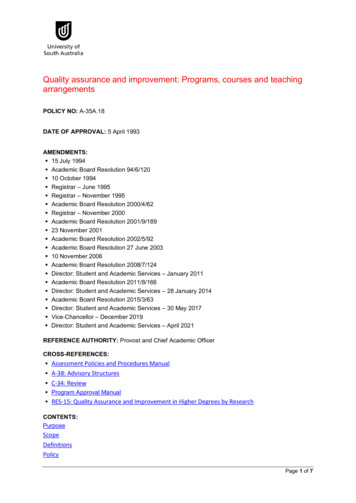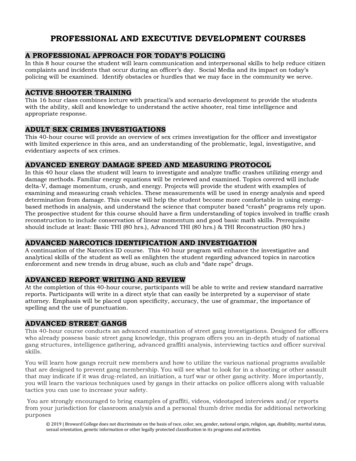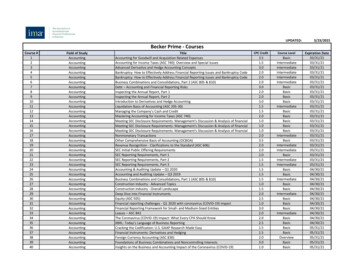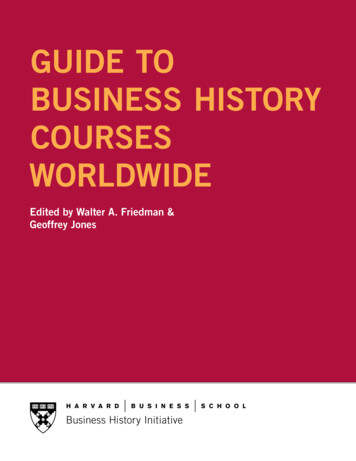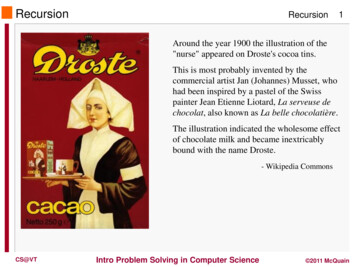
Transcription
RecursionRecursion1Around the year 1900 the illustration of the"nurse" appeared on Droste's cocoa tins.This is most probably invented by thecommercial artist Jan (Johannes) Musset, whohad been inspired by a pastel of the Swisspainter Jean Etienne Liotard, La serveuse dechocolat, also known as La belle chocolatière.The illustration indicated the wholesome effectof chocolate milk and became inextricablybound with the name Droste.- Wikipedia CommonsCS@VTIntro Problem Solving in Computer Science 2011 McQuain
Recursive DefinitionsrecursionRecursion2a method of defining functions in which the function being defined isapplied within its own definition1n 0 factorial (n) n factorial (n 1) n 0factorial(5)CS@VT 5 * factorial(4) 5 * (4 * factorial(3)) 5 * (4 * (3 * factorial(2))) 5 * (4 * (3 * (2 * factorial(1)))) 5 * (4 * (3 * (2 * 1))) 120Intro Problem Solving in Computer Science 2011 McQuain
Recursive DefinitionsRecursion31n 0,1 fibonacci(n) fibonacci(n 1) fibonacci(n 2) n 1fibonacci(4) fibonacci(3) fibonacci(2)fibonacci(2) fibonacci(1) fibonacci(1) fibonacci(0) fibonacci(1) fibonacci(0) fibonacci(1) fibonacci(1) fibonacci(0)CS@VT 1 1 1 1 1 5Intro Problem Solving in Computer Science 2011 McQuain
Recursion NecessitiesRecursion4Every recursive algorithm must possess:-a base case in which no recursion occurs-a recursive caseThere must be a logical guarantee that the base case is eventually reached, otherwise therecursion will not cease and we will have an infinite recursive descent.Recursive algorithms may compute a value, or not.CS@VTIntro Problem Solving in Computer Science 2011 McQuain
Extended Pseudo-codeRecursion5To express recursive algorithms, we need to extend the pseudo-code notation to incorporatethe notion of an interface to an algorithm:algorithm name takes list of inputs For example:algorithm XtoN takes number X, number N# Computes the value of X N.# Pre: X, N are integers, N 0.#number XtoN# result. . .display XtoNhaltCS@VT# report resultIntro Problem Solving in Computer Science 2011 McQuain
Extended Pseudo-codeRecursion6We must also be able to express the invocation of an algorithm: name ( list of input values to algorithm )For example:algorithm fiboN takes number N# Computes the value of the N-th Fibonacci number.# Pre: N is a non-negative integer.#if N 2# base casedisplay 1endifdisplay fiboN(N-1) fiboN(N-2)haltCS@VT# recursive caseIntro Problem Solving in Computer Science 2011 McQuain
Printing a Large IntegerRecursion7Very large integers are (somewhat) easier to read if they are not simply printed as asequence of digits:12345678901234567890 vs 12,345,678,901,234,567,890How can we do this efficiently? The basic difficulty is that printing proceeds from left toright, and the number of digits that should precede the left-most comma depends on thetotal number of digits in the number.Here's an idea; let N be the integer to be printed, then:if N has no more than 3 digits, just print it normallyotherwiseprint all but the last 3 digitsprint a comma followed by the last 3 digitsCS@VTIntro Problem Solving in Computer Science 2011 McQuain
Printing a Large IntegerRecursion8algorithm printWithCommas takes number N# Prints N with usual comma-separation.# Pre: N is an integer.#if N 0display '-'N : -Nendif# handle negative sign, if necessaryif ( N 1000 ) # base casedisplay NelseprintWithCommas( N / 1000) # integer division!display ','display N % 1000 with 0's for paddingendifhaltCS@VTIntro Problem Solving in Computer Science 2011 McQuain
Recursion vs IterationRecursion9It is a mathematical theorem that any recursive algorithm can be expressed withoutrecursion by using iteration, and perhaps some auxiliary storage.The transformation from recursion to iteration may be simple or very difficult.algorithm facN takes number Nalgorithm facN takes number N# Computes the value of N!.# Pre: N is a non-negative integer.# Computes the value of N!.## Pre:if N 2# basecase N is a non-negative integer.#display 1number Fac# resultendifFac : 1display N * facN(N-1) # recursivecasewhile N 0haltFac : N * FacN: N - 1enwhiledisplay FachaltCS@VTIntro Problem Solving in Computer Science 2011 McQuain
Tail RecursionRecursion 10(pure) tail recursionthere is a single recursive call, and when it returns there are no subsequentcomputations in the calleralgorithm GCD takes number M, number N# Computes the largest integer that divides both M and N.# Pre: M,N are a non-negative integers, not both 0.# Credit: Euclid#ifN 0display Mendif# base casedisplay GCD(N, M % N)halt# recursive caseTail-recursive algorithms are particularly easy to transform into an iterative form.CS@VTIntro Problem Solving in Computer Science 2011 McQuain
"Near" Tail RecursionRecursion 11"near" tail recursionthere is a single recursive call, and when it returns there are only trivial subsequentcomputations in the caller; often called augmenting recursionalgorithm facN takes number N# Computes the value of N!.# Pre: N is a non-negative integer.#if N 2# base casedisplay 1endifdisplay N * facN(N-1) # recursive casehalt"Near" tail-recursive algorithms are often easy to transform into an iterative form.CS@VTIntro Problem Solving in Computer Science 2011 McQuain
K Queens ProblemRecursion 12Given a KxK chessboard, find a way to place K queens on the board so that no queen canattack another queen.A queen can move an arbitrary number of squares vertically, horizontally or diagonally.It's immediately clear that there must beone queen in every row and one queen inevery column.Here is one solution:There are over 4 billion different ways todrop 8 queens onto an 8x8 board.It's known that there are exactly 92distinct solutions to the problem.CS@VTIntro Problem Solving in Computer Science 2011 McQuain
4 Queens ProblemRecursion 13Let's consider a variant on a 4x4 board how to start?Let's flag squares that are under attack with Xs, since wecannot put a queen there.Let's process the board row by row, from the top down.XXXLet's start by putting a queen in the first square in row 1:XXXXXNow for row 2 we have two choices, let's try the first one:Oops now all the squares in row 3 are under attack, so thiscannot lead to a solution XXXXXXCS@VTIntro Problem Solving in Computer ScienceXXXXXXXX 2011 McQuain
4 Queens ProblemRecursion 14What to try next?Let's backtrack take back the last move and try adifferent one:XXXXXXXOK, now we have possibilities let's fill the freesquare in row 3:XRats! Now there are no free squares left in row 4.XXXXXXXXXXXXXXXXXWe can backtrack again, but that means we must nowremove the 2nd and 3rd queens, since we've alreadytried all the possibilities for the 2nd one, and then wemust consider a different spot for the 1st one CS@VTIntro Problem Solving in Computer Science 2011 McQuain
4 Queens ProblemRecursion 15So, we'll try the 1st queen in column 2:XXXXXXXXXThat leaves just one place for a queen in row 2:XXXXXXXXCS@VTIntro Problem Solving in Computer ScienceXXX 2011 McQuain
4 Queens ProblemAnd, that leaves just one place for a queen in row 3:Recursion 16XXXAnd, that leaves just one place for a queen in row 4:XXXXXXXXXXXXXXXXXXXXXAnd, we have a solution now can we deduce an algorithm?CS@VTIntro Problem Solving in Computer Science 2011 McQuain
K Queens ProblemRecursion 17Let's suppose we have some way to represent a board configuration (size, location ofqueens, number of queens, etc.)K Queens AlgorithmTry config takes configuration C, number mif C contains K queensdisplay Chaltendiffor each square in row m of Cif square is freeplace a queen in squareTry config(C, m 1)# leads to soln?remove queen from square# no, backtrackendifCS@VTIntro Problem Solving in Computer Science 2011 McQuain
Towers of HanoiRecursion 18Move one disk at a timeNo disk can sit on a smaller disk123Get all disks from pole 1 to pole 3Algorithm idea:Move top n-1 disks to pole 2Move bottom disk to pole 3Move disks from pole 2 to pole 3CS@VTIntro Problem Solving in Computer Science 2011 McQuain
Analyzing CostRecursion 19How many times must a disk be moved from one pole to another to solve the problem?Call this hanoi(n) where n is the number of disks; then from the preceding slide we have:1n 1 hanoi (n) 2hanoi(n 1) 1 n 1Hmm recursion again.This is an example of a recurrence relation (as are factorial and fibonacci seen earlier).Now this does indicate that adding one more disk causes the number of disk moves to moreor less double.CS@VTIntro Problem Solving in Computer Science 2011 McQuain
Closed-form SolutionsRecursion 20But, we'd really like to have a closed-form (non-recursive) formula for hanoi(n) since thatmight be faster to evaluate.Here it is:hanoi(n) 2n 1For more information on useful techniques for solving recurrence relations, take Math 3134or CS 4104.CS@VTIntro Problem Solving in Computer Science 2011 McQuain
fibonacci(4) fibonacci(3) fibonacci(2) fibonacci(2) fibonacci(1) fibonacci(1) fibonacci(0) . Given a KxK chessboard, find a way to place K queens on the board so that no queen can attack another queen. A queen can move an arbitrary


